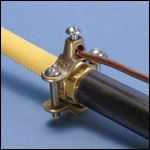Sparky Marky
Member
- Location
- Berks County, PA USA
250.104(B) does not specifically state where you must attach the bonding jumper to the gas pipe, other than that it must be accessible. However, especially where CSST is present, is there a connection point that would be more effective for protecting the CSST from damage due to lighting? I would assume that if the house is piped in such a manner that the metal gas pipe enters the building, and CSST is only used to branch out and directly connect to the appliances, then it makes no difference where you connect on the metal piping. However, I can't be sure, but I thought I had seen installations where CSST was used as a flexible connection between sections of metal pipe. It seems to me that in a case like that, you would want to bond to the section of metal piping that is uninterrupted from the main supply, and at least install bonding jumpers around any of the CSST flexible joints. Any thoughts?
Also, what material are the clamps that most of you use for metal gas pipe bonding? Around here the supply houses stock what I assume are a galvanized clamp. Today I asked for bronze or brass, which are obviously way more expensive too, and they didn't have any at that branch. I've used the galvanized for copper water pipe without any problems from any inspectors, but are they typically accepted on metal gas piping as well?
Thanks to all who reply.
-Mark
Also, what material are the clamps that most of you use for metal gas pipe bonding? Around here the supply houses stock what I assume are a galvanized clamp. Today I asked for bronze or brass, which are obviously way more expensive too, and they didn't have any at that branch. I've used the galvanized for copper water pipe without any problems from any inspectors, but are they typically accepted on metal gas piping as well?
Thanks to all who reply.
-Mark


